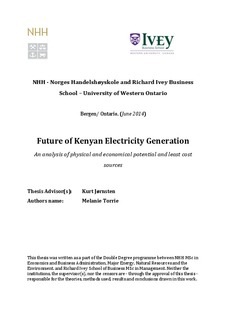Future of Kenyan electricity generation : an analysis of physical and economical potential and least cost sources
Abstract
Kenya has always had a renewable energy mix, with over 80 percent of electricity generated from renewable sources. As the country continues to develop, and in order to meet the growing demand for electricity, Kenya is considering using non-‐renewable sources. There are many studies on energy in Africa, and some on the potential for renewable energy in Kenya. However, there are currently no comprehensive studies on the physical potential and costs of electricity generation in Kenya. This paper seeks to fill this gap. This paper calculates the physical and economic potential for three electricity sources, solar, wind and biomass for Kenya. Then the Levelized Cost of Electricity is calculated for eight energy sources: solar, wind, geothermal, biomass, diesel, nuclear, coal and gas. In order to ensure robust results, this paper conducts two sensitivity analyses, one using a high and low discount and escalation rate, and one using high, medium and low carbon tax rates. Based on the results of these analyses, the most abundant and economical energy sources identified in this paper are wind, nuclear, biomass and solar. The paper then discusses the benefits and challenges of each of these sources. The benefits of the sources range from modularity to base-‐load capacity, and the challenges from intermittency to location dependency. Creating a mix of the four identified sources effectively mitigates most of the challenges of these sources. However, to mitigate some issues, such as the political nature of nuclear power, vigorous government and safety programs must be in place. The final issue the paper discusses is the issue of coal in Kenya’s electricity future. Since the discovery of economic reserves in 2010, Kenya has been debating the role coal will play in its future. The discussion debates the future of coal in Kenya from both a developmental and environmental perspective.
